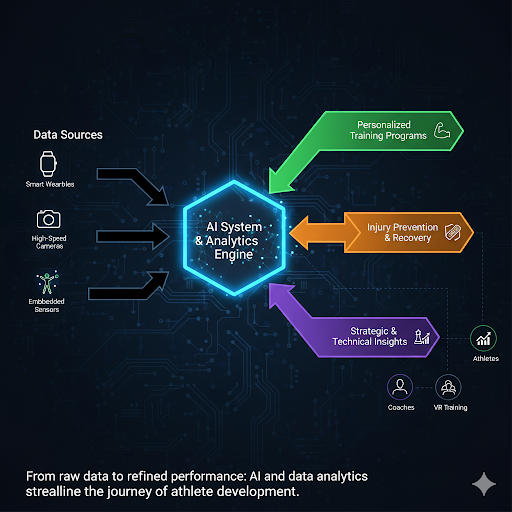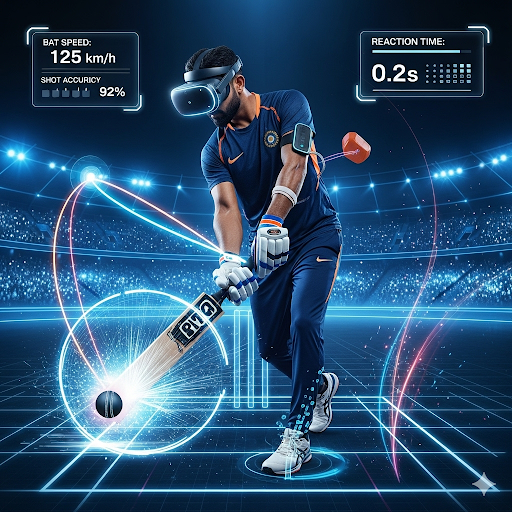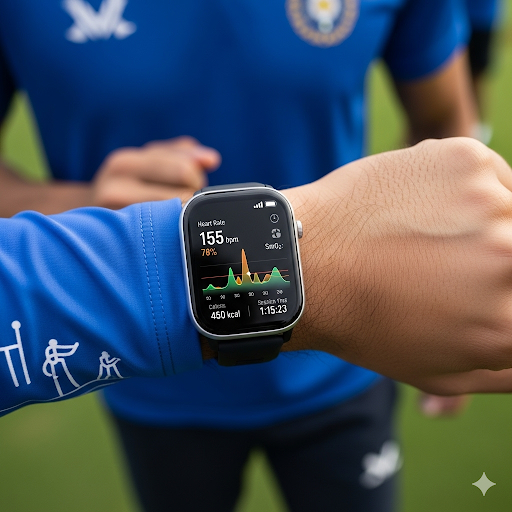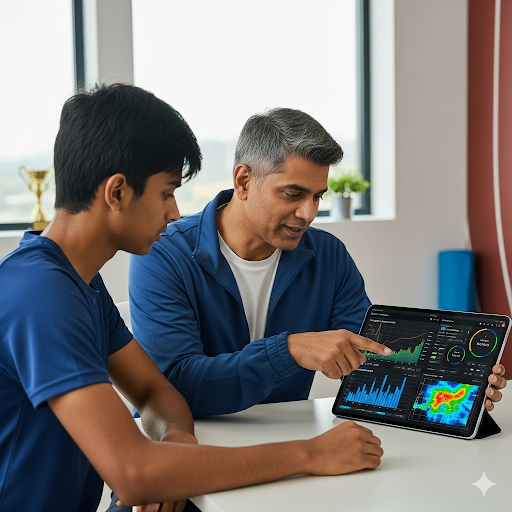AI and Data Analytics: Revolutionizing Athlete Performance in 2025
AI and data analytics are revolutionizing athlete performance. By integrating VR and smart wearables, this data-driven revolution is set to redefine training and competitive excellence in sports by 2025.

The world of sports is constantly evolving, with athletes pushing the boundaries of human potential. In this relentless pursuit of excellence, artificial intelligence (AI) and data analytics have emerged as game-changers, revolutionizing how athletes train, prevent injuries, and enhance performance. As we look towards 2025, the integration of these technologies, alongside innovations like Virtual Reality (VR) training and smart wearables, is set to transform athlete development in unprecedented ways.
The Data-Driven Athlete: A New Era of Training
For decades, coaching has relied heavily on intuition, experience, and qualitative observation. While invaluable, these methods often lacked the precision and depth that modern sports demand. Enter data analytics, which has transformed athletes into data-generating machines. From the moment an athlete steps into the field or into the gym, a wealth of information is being collected, processed, and analyzed.

What Data Are We Talking About?
The scope of data collection in sports is vast and ever-expanding. It encompasses:
- Physiological Data: Heart rate, oxygen saturation, sweat rate, muscle activity (EMG), sleep patterns, and recovery markers.
- Biomechanical Data: Movement patterns, joint angles, force production, stride length, sprint times, and jump heights. This often comes from motion capture systems, high-speed cameras, and force plates.
- Tactical Data: Player positioning, passing accuracy, shot selection, defensive movements, and decision-making during gameplay. This is particularly crucial in team sports.
- Environmental Data: Temperature, humidity, altitude, and even playing surface conditions can impact performance and are increasingly being factored into analysis.
- Nutritional and Psychological Data: Diet logs, hydration levels, mood assessments, stress levels, and cognitive performance tests are also becoming integral parts of an athlete's data profile.
The Power of AI in Data Interpretation
Collecting raw data is only the first step. The true revolution lies in the application of AI algorithms to interpret this massive influx of information. AI systems can identify subtle patterns, correlations, and anomalies that would be impossible for the human eye to detect.
- Predictive Analytics: AI can predict an athlete's potential performance, assess the risk of injury, or even forecast the outcome of a game based on historical data and current conditions. For instance, an AI model might analyze a cricketer's bowling action and predict the likelihood of a stress fracture based on subtle deviations over time.
- Personalized Training Programs: Instead of one-size-fits-all approaches, AI crafts highly individualized training plans. It considers an athlete's unique physiological responses, recovery rates, and specific performance goals. If an athlete's data indicates fatigue in a particular muscle group, AI can adjust the next day's training to focus on recovery or strengthen a complementary area.
- Real-time Feedback: During training sessions, AI-powered systems can provide immediate feedback to athletes and coaches. Imagine a gymnast performing a routine with sensors on their body; the AI can instantly highlight imbalances or inefficiencies in their movements, allowing for immediate correction.
Injury Prevention: A Proactive Approach
One of the most significant impacts of AI and data analytics is in the realm of injury prevention. Injuries are not just physical setbacks; they can be career-ending and have profound psychological effects on athletes. The traditional approach to injury prevention often involved reactively addressing problems after they occurred. With AI, the focus shifts to a proactive, predictive model.
Identifying Risk Factors
AI algorithms can analyze an athlete's complete data profile to identify specific risk factors for various injuries. This includes:
- Biomechanical Stress: Analyzing movement patterns during training and competition can highlight areas where excessive stress is placed on joints or muscles. For example, an AI might detect a slight asymmetry in a runner's stride that, over time, could lead to a knee injury.
- Fatigue Monitoring: Overtraining is a major cause of injury. AI constantly monitors physiological markers and training load to detect early signs of fatigue, recommending rest or reduced intensity before an injury occurs.
- Historical Data Analysis: By cross-referencing an athlete's current data with a vast database of previous injuries in similar athletes, AI can identify patterns that might indicate an increased risk.
Tailored Interventions
Once risk factors are identified, AI can suggest targeted interventions. This could include:
- Specific Strengthening Exercises: Recommending exercises to strengthen weak muscle groups identified as vulnerable.
- Adjustments in Training Load: Modifying the intensity, volume, or frequency of training to prevent overexertion.
- Recovery Protocols: Suggesting specific recovery strategies like targeted massage, cryotherapy, or nutritional adjustments based on the athlete's current physiological state.
In India, where sports science infrastructure is still developing in many areas, AI-powered injury prevention tools can be particularly impactful. They can democratize access to sophisticated analysis, allowing athletes and coaches in diverse regions to benefit from advanced sports science, even without a full team of on-site experts.
Performance Enhancement: Unlocking New Levels
Beyond preventing setbacks, AI and data analytics are instrumental in pushing the boundaries of performance enhancement. Every fraction of a second, every centimeter, and every point counts in elite sports, and these technologies provide the edge needed to compete at the highest level.
Strategic Insights
In team sports, AI analyzes vast amounts of game data to provide strategic insights:
- Opponent Analysis: AI can dissect an opponent's playing style, identifying strengths, weaknesses, common patterns, and individual player tendencies. This allows coaches to develop highly specific game plans.
- Optimal Play Calling: During a match, AI could potentially provide real-time recommendations for play calling in sports like football or basketball, based on current game state and opponent positioning.
- Talent Identification: AI can analyze the performance data of young athletes to identify those with the highest potential, even in early stages, making talent scouting more efficient and objective.
Technique Refinement
Individual athletes benefit immensely from AI's ability to refine technique:
- Biomechanics Optimization: AI can analyze an athlete's technique in detail, comparing it to ideal models or past successful performances. For a javelin thrower, AI might identify a subtle wrist movement that, if adjusted, could add meters to their throw.
- Skill Development: In sports requiring complex motor skills, AI can break down movements into granular components, providing feedback on each part of the action, accelerating the learning process.
The Rise of VR Training: Immersive and Adaptive
While data analytics provides the "what" and "why," Virtual Reality (VR) training offers the "how" in an immersive and highly effective manner. VR is moving beyond mere gaming to become a serious tool in athlete development.

Simulating Real-World Scenarios
One of VR's greatest advantages is its ability to simulate highly realistic and challenging scenarios without the physical risks or logistical constraints of real-world training.
- Replicating Game Pressure: A footballer can practice penalty kicks in a virtual stadium filled with roaring crowds, simulating match pressure without the physical toll.
- Cognitive Training: Athletes can train their decision-making skills in a highly dynamic environment. A basketball player can practice reading defenses and making split-second passing decisions against virtual opponents.
- Rehabilitation: For injured athletes, VR offers a safe environment to perform movements and gradually build strength and confidence before returning to full training.
Personalized and Adaptive Environments
VR training environments can be dynamically adjusted based on an athlete's performance and data.
- Difficulty Scaling: If an athlete is mastering a particular skill, the VR system can automatically increase the difficulty, add more variables, or introduce new challenges.
- Scenario Customization: Coaches can create bespoke scenarios that address specific weaknesses or prepare for particular opponents.
In India, VR training can be a cost-effective way to provide elite training environments and highly specialized coaching to a wider pool of athletes, especially in sports where access to top-tier facilities is limited.
Smart Wearables: The Athlete's Constant Companion
Smart wearables are the bridge between the athlete and the data analytics system. These increasingly sophisticated devices are becoming integral to daily training and monitoring.

Beyond Basic Tracking
Early wearables focused on basic metrics like steps and heart rate. Today, they offer a comprehensive array of data:
- GPS Trackers: For outdoor sports, providing insights into speed, distance, acceleration, and movement patterns.
- Biometric Sensors: Embedded in clothing, patches, or wristbands, these monitor everything from heart rate variability (a key indicator of recovery) to galvanic skin response (stress levels).
- IMU Sensors (Inertial Measurement Units): Found in smart shoes, headbands, or even specialized clothing, these track subtle movements, angles, and forces, providing detailed biomechanical feedback.
- Smart Patches and Apparel: These can monitor hydration levels, core body temperature, and even muscle oxygenation, providing critical insights into an athlete's physiological state.
Real-time Insights and Feedback
The beauty of smart wearables lies in their ability to provide real-time insights. An athlete can glance at their smartwatch during a run to see if they are within their target heart rate zone, or a coach can monitor an entire team's workload simultaneously from a tablet.
The Future of Wearables
By 2025, wearables will be even more integrated and less obtrusive. We can expect:
- Seamless Integration: Devices will be virtually invisible, woven into everyday athletic wear.
- Advanced Biometric Monitoring: Continuous, non-invasive monitoring of blood lactate, glucose, and other critical biomarkers.
- Predictive Maintenance: Wearables will not only monitor the athlete but also potentially the equipment, signaling when shoes need replacing or other gear is underperforming.
Challenges and Ethical Considerations
While the promise of AI and data analytics in sports is immense, there are significant challenges and ethical considerations that need to be addressed.
Data Privacy and Security
The vast amount of personal and sensitive data collected from athletes raises serious concerns about data privacy and security. Who owns this data? How is it stored and protected? What are the implications of this data being accessed by third parties? Clear regulations and robust security measures are paramount.

The Human Element vs. Algorithmic Dependence
There's a fine line between using AI as a powerful tool and becoming overly reliant on it. The intuition, empathy, and holistic understanding of human coaches remain irreplaceable. AI should augment human decision-making, not replace it. The risk is that coaches might blindly follow algorithmic recommendations without considering individual athlete nuances or the broader human context.
Accessibility and Equity
The advanced technologies discussed here often come with a significant price tag. This raises concerns about accessibility and equity in sports. Will these advancements create an even wider gap between well-funded elite programs and grassroots initiatives? Efforts must be made to make these technologies more affordable and accessible to athletes at all levels, particularly in countries like India where resources can be stretched.
Bias in Algorithms
AI algorithms are only as good as the data they are trained on. If the data contains biases (e.g., predominantly from male athletes, or specific ethnic groups), the AI's recommendations might not be universally applicable or could even perpetuate existing biases. Ensuring diverse and representative datasets is crucial.
The Indian Context: Opportunities and Hurdles
India, with its vast talent pool and growing sports economy, stands at a unique juncture. The adoption of AI and data analytics in sports presents both immense opportunities and significant hurdles.
Opportunities:
- Unlocking Untapped Talent: AI can help identify and nurture talent from remote areas, overcoming geographical barriers in scouting.
- Optimizing Performance in Diverse Sports: Beyond cricket, sports like hockey, badminton, and kabaddi can significantly benefit from data-driven insights.
- Injury Management: Given the prevalence of injuries in Indian sports and often limited access to advanced medical facilities, AI for injury prevention and rehabilitation can be a game-changer.
- Cost-Effective Solutions: As AI and VR technologies become more refined, they can offer relatively cost-effective ways to provide high-quality training and analysis compared to building extensive physical infrastructure.
Hurdles:
- Infrastructure: The digital infrastructure, including reliable internet connectivity and access to high-performance computing, needs to be robust across the country.
- Skilled Workforce: There's a need to develop a workforce skilled in sports science, data analytics, and AI interpretation.
- Funding: Investment in sports tech from both government and private sectors is crucial.
- Cultural Adoption: Integrating new technologies requires a shift in mindset among coaches and athletes, moving away from traditional methods.
Conclusion
By 2025, the synergy between AI, data analytics, VR training, and smart wearables will have profoundly reshaped athlete performance. From hyper-personalized training regimens and proactive injury prevention to immersive skill development and strategic insights, these technologies are empowering athletes and coaches to achieve new heights. While ethical considerations and accessibility remain critical challenges to address, the future of athlete development is undeniably data-driven, intelligent, and incredibly exciting. The Indian sports landscape is poised to embrace this revolution, potentially unearthing and refining a new generation of champions.




